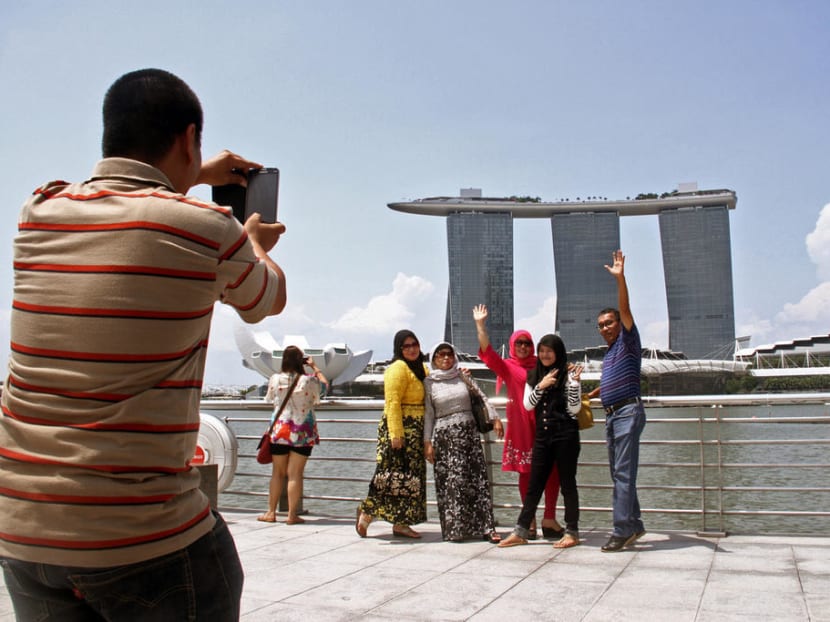Economies of Singapore, Thailand to be hardest hit in Asean by Wuhan virus: Analysts’ report
SINGAPORE — The economies of Singapore and Thailand are set to be the hardest hit in the region by the Wuhan coronavirus outbreak as they are more dependent on China's trade and tourism than their neighbours, a new report has found.

Both Singapore and Thailand are expected to take bigger hits from the Wuhan virus outbreak than their regional neighbours, in part because of the expected impact on tourism-related parts of the economy.
SINGAPORE — The economies of Singapore and Thailand are set to be the hardest hit in the region by the Wuhan coronavirus outbreak as they are more dependent on China's trade and tourism than their neighbours, a new report has found.
The report, by a team of analysts from financial services firm Maybank Kim Eng, cites several factors as to why the outbreak could be more economically damaging than the severe acute respiratory syndrome (Sars) pandemic in 2003.
One factor is that China’s economy is larger now compared to in 2003. Another factor is that the country is more connected to the wider world now.
But the report also points to factors that could soften the economic impact, such as China’s faster and more transparent response to the health crisis.
Authored by Dr Chua Hak Bin, Ms Lee Ju Ye and Ms Linda Liu, the report released on Thursday (Jan 30) states that the Wuhan virus outbreak has cast a shadow on the potential recovery of the manufacturing sector.
Malaysia and Vietnam will be negatively impacted by the outbreak, though not as much as Singapore and Thailand, while Indonesia and the Philippines will be the least affected among the 10 members of the Association of Southeast Asian Nations (Asean) as they are domestic-oriented economies, the analysts said.
The outbreak that began in Wuhan, the capital of China's central province of Hubei, has killed 170 people in the country and infected more than 7,800 globally, most of them in China.
It has also spread to 19 other places, with Singapore reporting 10 imported cases.
Here are the number of Wuhan virus cases in other Asean countries:
- Thailand: 14
- Malaysia: 7
- Vietnam: 2
- Cambodia: 1
IMPACT ON ASEAN
The analysts expect Singapore’s economy to take a hit, like how it did during Sars, with tourism-related sectors the worst affected.
The virus causing this recent outbreak belongs to the same family of viruses as Sars, which also spread from China to the rest of the world. More than 8,000 were infected and 774 killed globally.
Restaurants, retail trade and the land transport sectors in Singapore may suffer the greatest impact from the Wuhan virus, the report said.
While consumer sales are also expected to go down, the analysts believe that the eventual blow will not be too painful given that e-commerce transactions now make up 6 per cent of all retail sales.
Using Sars as a reference point, Ms Selena Ling, an economist at OCBC, said in a research note on Thursday that Singapore’s economic growth could potentially go down by 0.5 to 1 percentage points if the current outbreak lasts for more than three to six months.
The Maybank Kim Eng analysts also expect Thailand to be negatively impacted, given that it is the largest tourist destination for mainland Chinese travellers, outside of Hong Kong and Macau.
Tourism authorities in Thailand expect Chinese tourists to fall to nine million in 2020, down from 11 million in 2019, due to the ban on group tours going out of China. This would translate to a loss of about US$1.7 billion (S$2.3 billion), or 0.3 per cent of its economic output.
Malaysia will also be affected by the decline in Chinese tourists, especially its casino sector. But some other parts of the economy, such as its medical gloves production sector, have benefited from the Wuhan virus outbreak.
Ms Agathe Demarais, global forecasting director at The Economist Intelligence Unit, said Asean countries that depend on Chinese tourism would be most impacted.
SINGAPORE BUDGET MEASURES
The analysts expect that Budget 2020, to be delivered on Feb 18, will include measures to help businesses hardest hit by the Wuhan virus, specifically the tourism and consumer-related sectors.
The report states that the Government may lower foreign worker levies for the hotel and food and beverage industries.
Trade and Industry Minister Chan Chun Sing said on Monday that the Government is working with the labour movement and various trade associations to develop support measures, but stopped short of confirming that these will be introduced in the Budget.
Manpower Minister Josephine Teo reiterated this on Thursday, during a briefing ahead of the advance release of the labour market report for the fourth quarter.
DIFFERENCE BETWEEN THE WUHAN VIRUS AND SARS
Mrs Teo said that the current situation with the Wuhan virus is “significantly different” from when Singapore was coping with Sars.
There were more unknowns when Sars first spread, and there was a fairly long period when authorities were “grappling in the dark”.
“Today it is all about organising the response, today very clearly we know it is about containment.”
Mrs Teo also said that Singapore’s economy is more diversified than in 2003, with the tourism and hospitality sector accounting for a smaller share of the economy.
However, she added that Singapore should still “expect unknown unknowns”.
The Maybank Kim Eng analysts highlighted other differences between Sars and the Wuhan virus.
For one thing, they expect the number of patients infected with the Wuhan virus to exceed Sars, because the former is more infectious.
However, the number of deaths will likely be lower than the 774 during Sars due to China’s early warnings and rapid containment measures and the fact that early signs indicate that the fatality rate for the Wuhan virus is 3 per cent, against 10 per cent for Sars.
WHY THE WUHAN VIRUS OUTBREAK COULD BE LESS DAMAGING THAN SARS
Faster and more transparent policy response
China has implemented a faster and more aggressive policy response to contain the Wuhan virus outbreak.
Sars was allowed to spread for longer as China only officially went public to the World Health Organization in February 2003, several months after the virus emerged in late 2002.
However, this time China was more transparent and took proactive measures to contain the Wuhan virus, such as putting Wuhan and several other cities around it in lockdown.
Other governments have also responded quickly, said the analysts, with several countries imposing travel restrictions and leave of absence for some people coming back from China.
More efficient communication among healthcare experts
Public health experts from China are sharing genetic information of the Wuhan virus to researchers globally.
It took four months for the Sars genome to be published.
WHY THE WUHAN VIRUS OUTBREAK COULD BE WORSE THAN SARS
While the aggressive measures could shorten the duration of the virus outbreak, the analysts said that it could sacrifice economic growth in the short term.
Economic growth was hurt for one quarter during Sars but it quickly recovered in the subsequent quarter for Singapore, Hong Kong, Taiwan and China. The rest of Asean suffered only a minimal impact.
The impact was mainly felt in the tourism and transport sectors, as visitor arrivals plunged across the whole of Asean.
There is, however, a risk of a larger negative impact this time because:
China is now a far larger economy taking a bigger share of regional exports
China is more connected to the world
Chinese tourist arrivals have been a major growth engine for Asean
The size of China’s economy
China’s share of global economic output grew to 18.6 per cent in 2018, from just 9 per cent in 2003. This means that Asean economies are now a lot more dependent on China’s growth.
China’s market share of Asean exports is at 14 per cent in 2018, compared to 6.5 per cent in 2003.
China’s connectivity with the world
The risk of the virus spreading has increased compared with 2003 along with China’s greater global connectivity.
International air passenger traffic from China has more than quadrupled from 15 million in 2008 to 64 million in 2018.
Chinese tourists
Chinese tourists in Asean have grown almost 10 times, from 2.9 million in 2003 to 27 million in 2018.
Tourism receipts from Chinese travellers have been growing in importance as a contributor to Asean economies.
China’s move to ban outbound group tours will hurt Asean, said the analysts.








